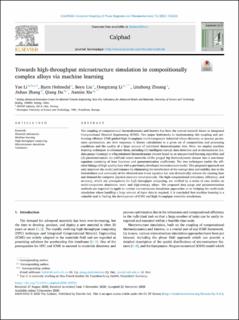| dc.contributor.author | Li, Yue | |
| dc.contributor.author | Holmedal, Bjørn | |
| dc.contributor.author | Liu, Boyu | |
| dc.contributor.author | Li, Hongxiang | |
| dc.contributor.author | Zhuang, Linzhong | |
| dc.contributor.author | Zhang, Jishan | |
| dc.contributor.author | Du, Qiang | |
| dc.contributor.author | Xie, Jianxin | |
| dc.date.accessioned | 2022-09-19T07:22:34Z | |
| dc.date.available | 2022-09-19T07:22:34Z | |
| dc.date.created | 2021-04-13T15:33:42Z | |
| dc.date.issued | 2021 | |
| dc.identifier.citation | Calphad. 2021, 72 1-9. | en_US |
| dc.identifier.issn | 0364-5916 | |
| dc.identifier.uri | https://hdl.handle.net/11250/3018673 | |
| dc.description.abstract | The coupling of computational thermodynamics and kinetics has been the central research theme in Integrated Computational Material Engineering (ICME). Two major bottlenecks in implementing this coupling and performing efficient ICME-guided high-throughput multi-component industrial alloys discovery or process parameters optimization, are slow responses in kinetic calculations to a given set of compositions and processing conditions and the quality of a large amount of calculated thermodynamic data. Here, we employ machine learning techniques to eliminate them, including (1) intelligent corrupt data detection and re-interpolation (i.e. data purge/cleaning) to a big tabulated thermodynamic dataset based on an unsupervised learning algorithm and (2) parameterization via artificial neural networks of the purged big thermodynamic dataset into a non-linear equation consisting of base functions and parameterization coefficients. The two techniques enable the efficient linkage of high-quality data with a previously developed microstructure model. This proposed approach not only improves the model performance by eliminating the interference of the corrupt data and stability due to the boundedness and continuity of the obtained non-linear equation but also dramatically reduces the running time and demand for computer physical memory simultaneously. The high computational robustness, efficiency, and accuracy, which are prerequisites for high-throughput computing, are verified by a series of case studies on multi-component aluminum, steel, and high-entropy alloys. The proposed data purge and parameterization methods are expected to apply to various microstructure simulation approaches or to bridging the multi-scale simulation where handling a large amount of input data is required. It is concluded that machine learning is a valuable tool in fueling the development of ICME and high throughput materials simulations. | en_US |
| dc.language.iso | eng | en_US |
| dc.publisher | Elsevier | en_US |
| dc.rights | Navngivelse 4.0 Internasjonal | * |
| dc.rights.uri | http://creativecommons.org/licenses/by/4.0/deed.no | * |
| dc.subject | Tabulation | en_US |
| dc.subject | Microstructure simulation | en_US |
| dc.subject | High-throughput computing | en_US |
| dc.subject | Machine learning | en_US |
| dc.subject | Materials informatics | en_US |
| dc.title | Towards high-throughput microstructure simulation in compositionally complex alloys via machine learning | en_US |
| dc.type | Peer reviewed | en_US |
| dc.type | Journal article | en_US |
| dc.description.version | publishedVersion | en_US |
| dc.rights.holder | © 2020 The Authors. Published by Elsevier Ltd. | en_US |
| dc.source.pagenumber | 1-9 | en_US |
| dc.source.volume | 72 | en_US |
| dc.source.journal | Calphad | en_US |
| dc.identifier.doi | 10.1016/j.calphad.2020.102231 | |
| dc.identifier.cristin | 1903841 | |
| dc.source.articlenumber | 102231 | en_US |
| cristin.ispublished | true | |
| cristin.fulltext | original | |
| cristin.qualitycode | 1 | |

